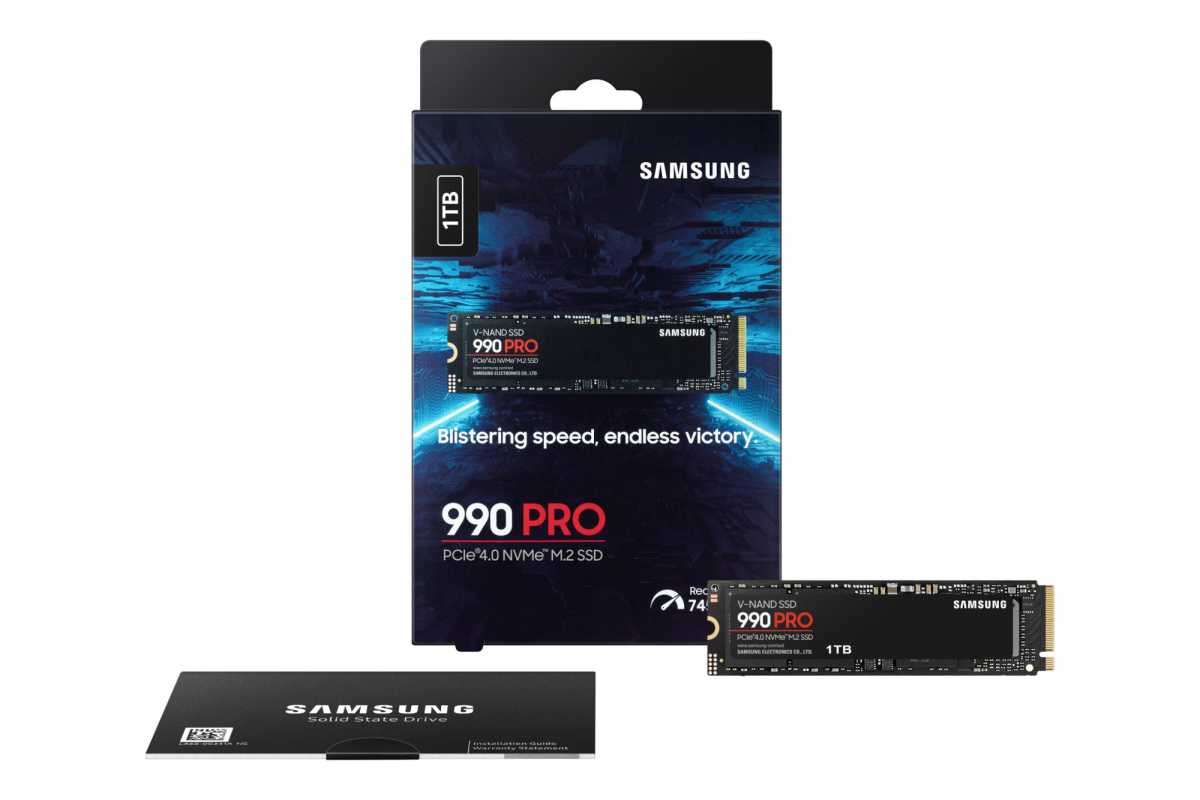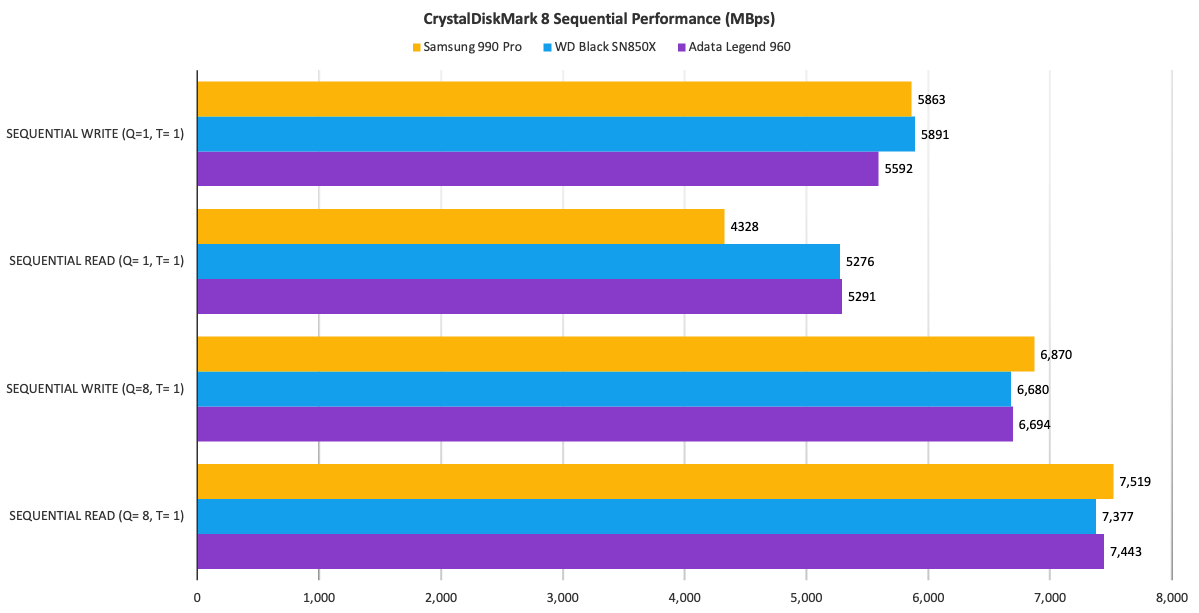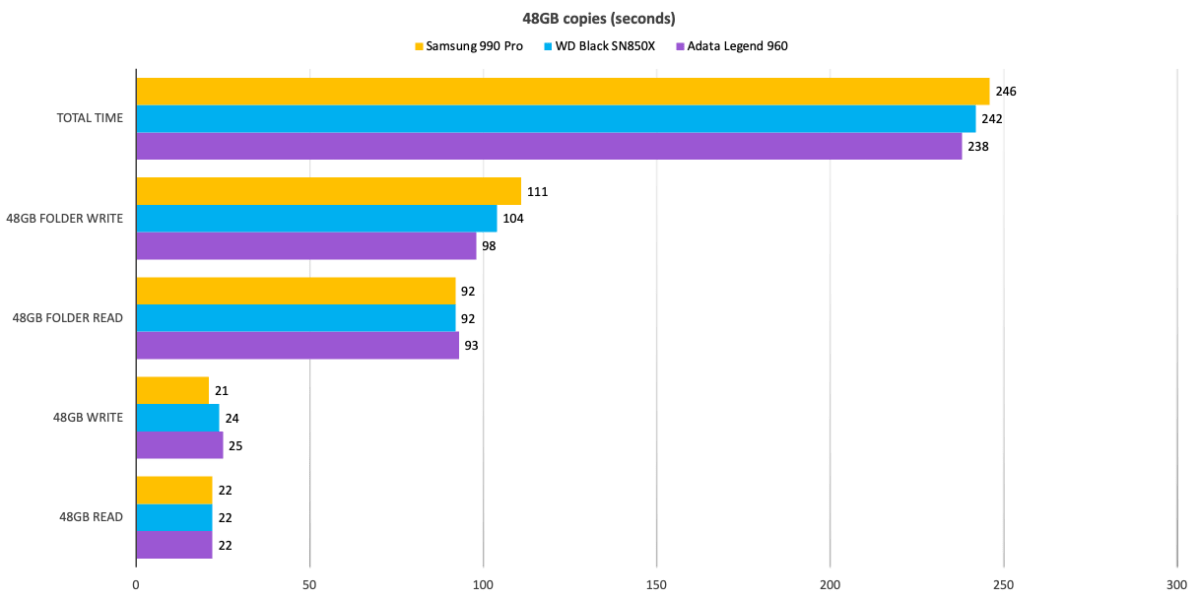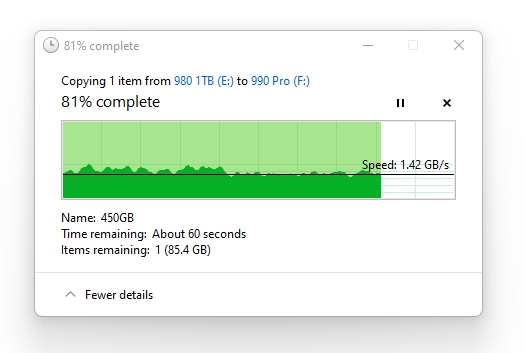
[ad_1]
 At a glance
At a glance
Expert’s Rating
Pros
- Top-tier everyday performance
- Available with and without heat sink
Cons
- Pricey
- Slightly off the pace with our 450GB write
Our Verdict
The Samsung 990 Pro NVMe SSD is a top-tier performer. That, and the company’s sterling reputation would make it an attractive option—if there weren’t equally competent drives available for quite a bit less.
Price When Reviewed
$240 for 2TB
The Samsung 990 Pro is one of the best NVMe SSDs on the market. But where once Samsung’s SSDs were ahead of the performance curve, this one is merely level with it—placing fourth overall in our testing.
It’s a very tight race for the top spot, but the 990 isn’t the winner, and Samsung still prices the 990 Pro as if it were a dominant performer. That currently makes it a bit of a hard sell.
Note: This review is part of our ongoing roundup of the best SSDs. Go there to learn more about competing products, what to look for in an SSD, and buying recommendations.
Samsung 990 Pro: Design and features
The 990 Pro is your standard 2280 form factor (22mm wide, 80mm long) M.2, NVMe SSD. It’s PCIe 4 x4 utilizing 176-layer TLC NAND, with 1GB of primary caching DRAM for every 1TB of NAND. The controller is an in-house Samsung design that, according to the company, offers a 50 percent improvement in power efficiency over the 980 Pro.
The 990 Pro is available either with a heatsink or without (tested). The label on the non-heatsink version also serves as a heat spreader, so unless you’re pounding on the drive constantly by transcoding high-resolution video or gaming, you probably don’t need the heatsink. Also, many performance motherboards provide their own heatsinks.
Retail pricing is $170 for the 1TB capacity, and $290 for the 2TB version sans heatsink. Add $20 if you want said heatsink. Those prices are significantly higher than what the top-ranked WD SN850X was available for on Amazon at the time of this writing.
We can only compare using the prices that the company provides until the drive actually shows up in retail. However, the older 980 Pro is just as heavily discounted as the SN850X, so if you see the 990 Pro for more competitive prices, that would make the drive a far more attractive purchase.

Samsung provides a five-year warranty which is mitigated by a 600TBW (terabytes that can be written) per 1TB endurance rating—i.e., the warranty expires when either limit is exceeded. TBW ratings are extremely conservative as a rule, so you will likely be able to write more to the drive.
600TBW per 1TB is actually quite a rather low allowance given the 990 Pro’s premium pricing.
Performance
In some tests, the 990 Pro rocked; in others it fell a bit off the pace of the other top competitors; and in one test (the long 450GB write), it was surprisingly mid-tier in performance. Add it all up and it was the fourth fastest drive we’ve tested, though not lagging by much. It’s an extremely tight contest between the best drives.
CrystalDiskMark 8 (shown below) was largely one of the 990 Pro’s strong points. It was fastest in two of the tests, and a hair behind in a third; however, a surprisingly weak single-queue read performance sabotaged its aggregate score. Note that the WD SN850X included in the comparison is the fastest drive overall we’ve tested to date.

If not for that weak single-queue/thread performance, the 990 Pro’s aggregate CrystalDiskMark 8 performance might’ve placed it only a tick out of first place. Note that this aggregate is our totaling of the results, not something CDM8 provides.

When it came to the real world, the 990 Pro was a bit behind the other top drives in small file/folder writes, but aced the single large-file write. The 21-seconds read speed is the fastest we’ve seen, matched only by the otherwise slower Teamgroup Cardea A440 Pro.

What did surprise us a bit was the 990’s uneven transfer rate while writing a 450GB file to its cells. With an empty 2TB SSD with plenty of NAND for use as SLC secondary cache, this is usually very smooth and even. The result was the 990 Pro lagging about a half minute off the pace set by the fastest performers in this test.

The numerous dips and bumps in speed you can see below were likely because of granular real-time allocation of more NAND for secondary cache duties. The best 450GB write time we’ve seen on our new test bed was 206 seconds by the 4TB Crucial P3. Having that much NAND helped the P3’s cause. It lagged in other areas.

The performance differences we’re pointing out here are minor. You could take any of the top PCIe 4 drives and never notice the difference subjectively. In other words, they’re all very, very fast.
Internal drive tests currently utilize Windows 11 64-bit running on an MSI MEG X570/AMD Ryzen 3700X combo with four 16GB Kingston 2666MHz DDR4 modules, a Zotac (Nvidia) GT 710 1GB x2 PCIe graphics card, and an ASMedia ASM3242 USB 3.2×2 card. Copy tests utilize an ImDisk RAM disk using 58GB of the 64GB total memory.
Each test is performed on a newly formatted and TRIM’d drive so the results are optimal. Over time, as a drive fills up, performance will decrease due to less NAND for caching and other factors.
The performance numbers shown apply only to the drive we were shipped and of the capacity tested. SSD performance can vary by capacity due to more or fewer chips to shotgun reads/writes across and the amount of NAND available for secondary caching. Vendors also occasionally swap components, though Samsung has traditionally changed model numbers for revisions.
Should you buy Samsung’s 990 Pro?
While Samsung’s 990 Pro didn’t set any records, it’s still one of a handful of drives vying for the top performance spot. It’s an excellent drive; however, much of its competition is significantly more affordable, making it harder to recommend.
[adinserter block=”4″]
[ad_2]
Source link